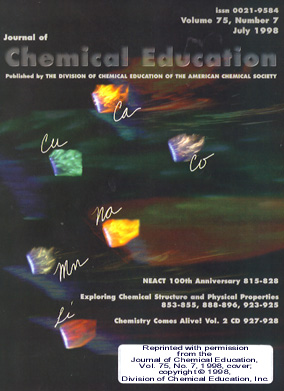

Proposed Research Description
for
SILO Advisory Council Undergraduate Research Fellowship
Spectroscopy with Color Scanners & Digital Cameras
This compelling cover photo for the Journal of Chemical Education shows the flames of various chemical elements. But, what is missing from this picture? Every chemical element has its own unique emission spectrum. Is it possible to identify these unique spectrum with the cameras and scanners that capture the colors and image of the photon emitting sources?
The goal of this project is to make it possible for anyone with a need or desire to do spectroscopy to be able to accomplish their goals with access to color scanners, digital cameras, appropriate software, and any miscellaneous equipment deemed necessary. The possibility of using a color scanner and/or digital camera directly as a spectroscope for light source emission spectrum analysis will be investigated. Questions to be answered concerning this are; 1. Is it possible to utilize a scanner or digital camera to produce a spectrum without a defraction grating or prism? 2. Do the internal mechanisms of scanners and digital cameras analyze a spectrum of a source in the process of capturing and reproducing color data? 3. If scanners and digital cameras do analyze a spectrum when focused on a light source emission, are they able to discern the different unique spectrum signatures produced by different elements? Can similar looking sources such as calcium and sodium in the picture be distinguished consistently? 4. If a defraction grating or prism is necessary for a true and complete analysis of an emission spectrum, then what equipment already exists to facilitate a color scanner or camera in capturing the spectrum? Can an apparatus be invented that would allow a camera to capture the image as perceived by the eye, and capture the unique spectrum simultaneously? This project will attempt to answer these questions and more.
Existing software such as ColorShop’s spectrum tool and colorimeter tool will be investigated to determine their degree of utility in providing the desired end product. Where existing products prove to be deficient, software program improvements that would enhance or replace the prior art will be attempted to be conceptualized and produced. Scanner and digital camera technology will be explored through existing patent research. Of key interest will be apparatus that utilize the natural wavelength and frequency spectrum information of visible light to process and reproduce color data. Are any wavelengths outside the visible spectrum perceived by any of this equipment, and what kind of resolution can be expected?
Background Information:
The mentor for this project, Dr. Brent E. Wurfel, received his Ph.D. From the University of California at Berkeley. He has designed and constructed spectrometers, including a liquid-helium cooled infrared photon counting spectrometer. He has mentored undergraduate and graduate students at the Technical University of Munich.
The student for this project, David B. Robert, is seeking a B.S. Degree in Computer Science. This student came to Dr. Wurfel’s attention by making a dual real time spectroscope that allows simultaneous comparison of a neon-bulb spectrum with the spectrum of any other sighted sources. The student’s resume evidences a fair amount of computer abilities. This should with the guidance of his mentor result in an exciting research project that ultimately achieves its goal of bringing a simple means of doing spectroscopy to the average person and school environment that has access to common office tools.
Research Schedule:
It is estimated that the project will require 160 hours to complete. The student intends to dedicate 4 hours a week during semesters toward its completion. Between semesters the student and the mentor plan on working together to test various theories and apparatus. Basically the project can be broken down into 4 time periods of 40 hours each. The first period will be used to accumulate information through Internet searches and existing patents. A utility Web site, which has already been started, will be used to facilitate communication between the student and the mentor while documenting and tracking the project’s progress. The second period will be used for the student and the mentor to test the various equipment and software the initial research determined to be of use. These findings will be documented on the project’s Web page. The third period will be used to arrive at conclusions, update and polish the project Web page, and prepare an article for possible publication in such journals as Scientific American, Journal of Chemical Education, American Journal of Physics, The Science Teacher, The Physics Teacher, and Review of Scientific Instruments. The forth and final period will be used to finalize conclusions, prepare a presentation, and give a presentation on the project. The project Web page will be finalized as a resource for others with a need for the information presented.
